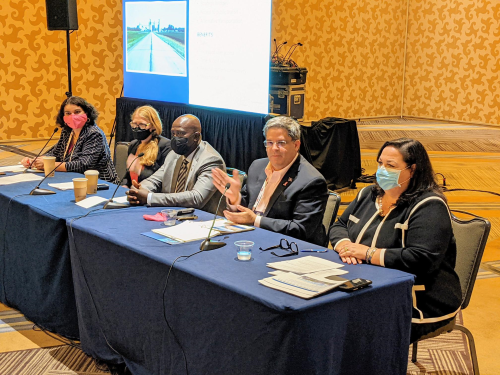FEDERAL ACTION
AASHTO Disappointed with Yet another Transportation Bill Extension – AASHTO News
Here’s what’s in the bipartisan infrastructure bill – CNN
Buttigieg defends bipartisan infrastructure bill, ‘optimistic’ it will pass – ABC News
U.S. Supreme Court to hear bid to curb federal power to limit carbon emissions – Reuters
COVID-19
Alaska Railroad rescinds employee vaccine mandate just days after announcing policy – Anchorage Daily News
FTA Recognizes Outstanding Rural Transit Agencies That Have Gone Above and Beyond for Their Communities Amid the Pandemic – FTA (Media Release)
Fact Sheet: Biden Administration Releases Additional Detail for Implementing a Safer, More Stringent International Air Travel System – White House (Media release)
NEPA
Proposed Legislative and Executive Branch Changes to NEPA Process – JDSupra
INFRASTRUCTURE RESILIENCE AND SUSTAINABILITY
Reconstruction of an urban highway in NC named nation’s top transportation project – Charlotte Observer
MoDOT project intends to help flood-prone stretch of Highway 67 rise above traffic woes – St. Louis Post-Dispatch
NJ TRANSIT Continues Resiliency Upgrades In Hoboken – NJ Transit (Media release)
AIR QUALITY
EPA Chief Michael Regan Touts Collaborative Approach of SmartWay Program – Transport Topics
FAA Administrator: Freedom to fly brings environmental responsibility – Runway Girl Network
More Urban Chargers Will Prompt EV Adoption, Experts Say – Government Technology
London expands vehicle levy to improve air quality – Reuters
Connecticut drivers have paid hundreds of millions in clean air and emissions fees. Where did they go? – Yankee Institute
States With Highest Portion Of Their CO2 Emissions Coming From Transportation: California, Washington, & Hawaii – US Department of Energy
ENVIRONMENTAL JUSTICE
This Squad of Researchers Is a Real-Life Justice League – Boston University
NATURAL RESOURCES
Arizona DOT Tests New ‘Watch for Animals’ Placards – AASHTO Journal
Keep it Clean, Arkansas campaign launched by ARDOT – Arkansas DOT
GDOT’s Wildflower Program provides pop of color along state highways – WMAZ-TV (Video)
Environmentalists and Chicago Rockford airport officials beg to differ over the Bell Bowl Prairie – WREX-TV
Wetlands are a nature-based solution to climate change – Vermont Business Magazine (Opinion)
CULTURAL RESOURCES
Loss of Fire Lookouts Spurs Questions About Historic Preservation – Columbia University
Can a Map Rekindle London’s Love of Walking? – CityLab
HEALTH AND HUMAN ENVIRONMENT/ACTIVE TRANSPORTATION
Massachusetts Considers Letting Electric Bikes in Bike Lanes – AP
DC makes roadway changes as part of fall safety campaign to protect pedestrians, bicyclists – WTOP Radio
Burlington airport monitoring sound levels following jet-noise complaints – VTDigger
Gov. Kathy Hochul Signs Legislation Cracking Down On Noise Pollution – WCBS-TV
A controversial connection? Thomasville Road multi-use trail in Tallahassee draws fire as planners gather input – Tallahassee Democrat
San Luis Obispo installs new pedestrian-bicycle bridge as part of Railroad Safety Trail project – The Tribune
Orlando Crosswalk Uses Infrared Heat Technology To Detect Pedestrians – WRBW-TV
TRB RESOURCES/ANNOUNCEMENTS
Clearing the Skies with Research on Electric Vehicles – TRB
TRB Webinar: Building Information Modeling for Infrastructure – TRB
Equity in University Research Centers Workshop – C2SMART Center (Link to registration)
FEDERAL REGISTER NOTICES
Port Access Route Study: Alaskan Arctic Coast; Reopening of Comment Period – Coast Guard (Notice)
Proposed Consent Decree, Safe Drinking Water Act Claims – EPA (Notice of proposed consent
decree; request for public comment)
Air Plan Approval; NC; Removal of Transportation Facilities Rules for Mecklenburg County – EPA (Proposed rule)
Notice of Intent To Prepare an Environmental Impact Statement for the Proposed Mayflower Wind Project on the Northeast Atlantic Outer Continental Shelf – Bureau of Ocean Energy Management (Notice; request for comments)
Request for Information on NOAA Actions To Advance the Goals and Recommendations in the Report on Conserving and Restoring America The Beautiful, Including Conserving At Least 30 Percent of U.S. Lands and Waters By 2030 – NOAA (Notice)
Endangered and Threatened Wildlife and Plants; Regulations for Designating Critical Habitat – U.S. Fish and Wildlife Service – (Proposed rule)
Endangered and Threatened Wildlife and Plants; Regulations for Listing Endangered and Threatened Species and Designating Critical Habitat – U.S. Fish and Wildlife Service and National Marine Fisheries (Proposed rule)




